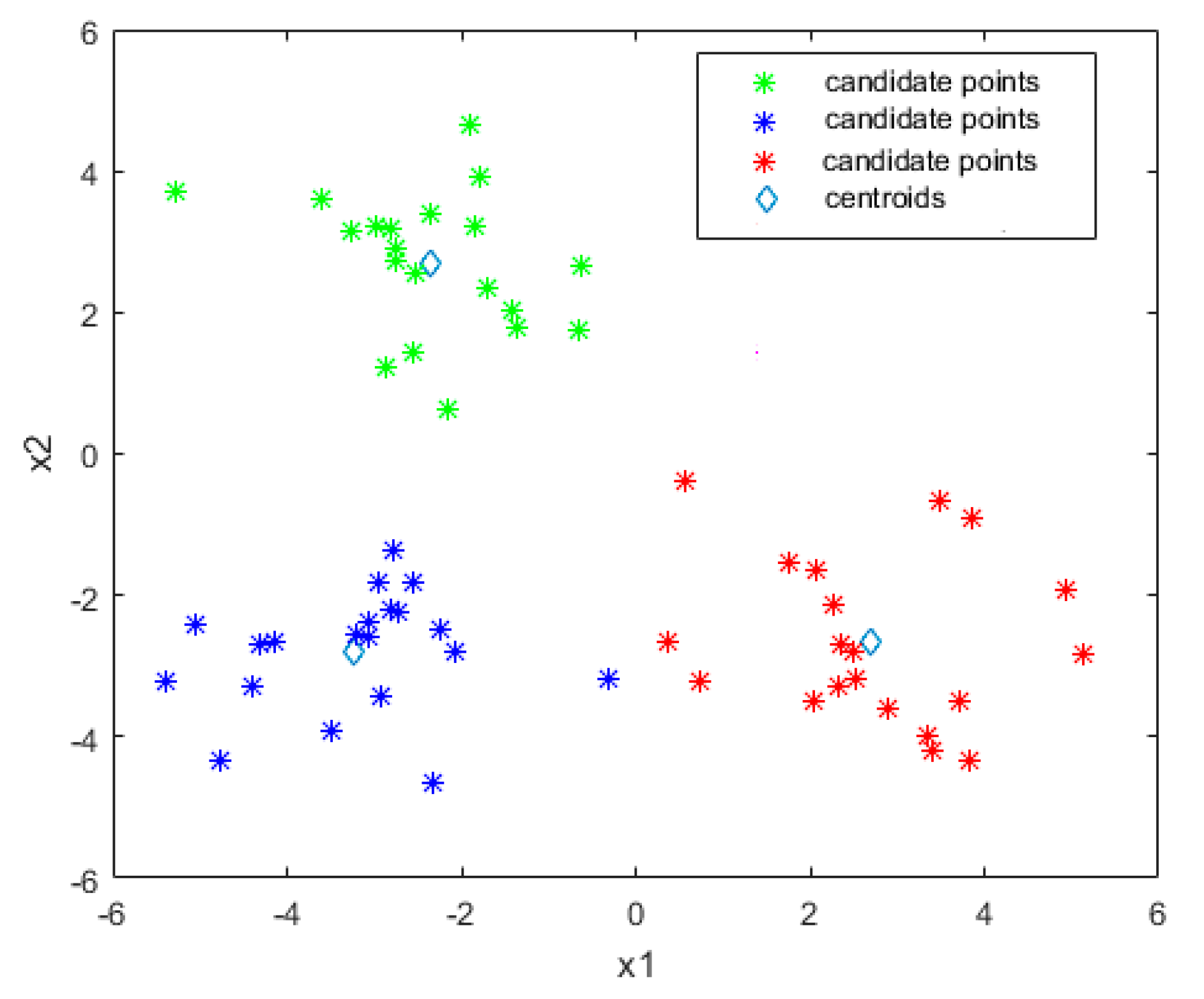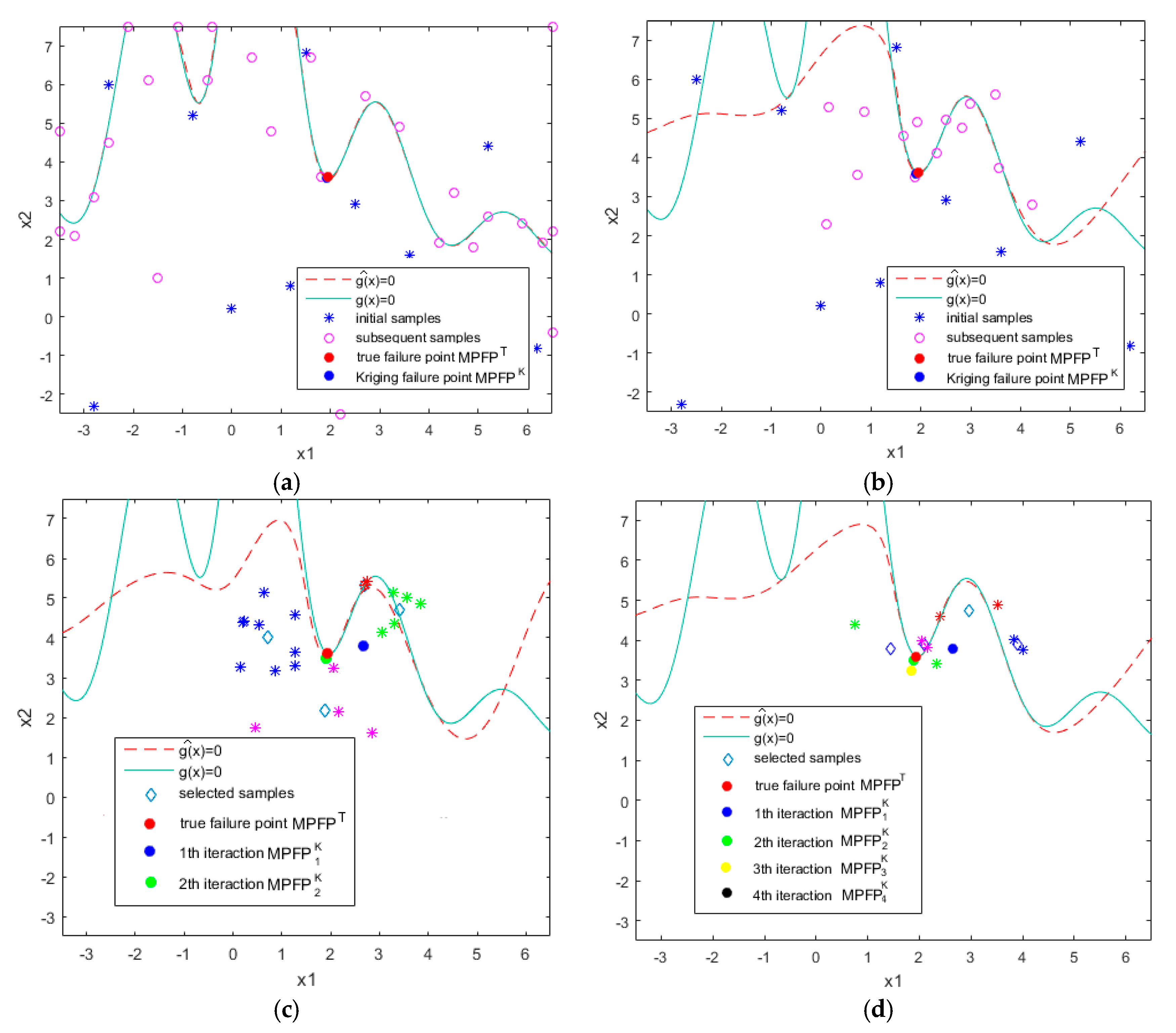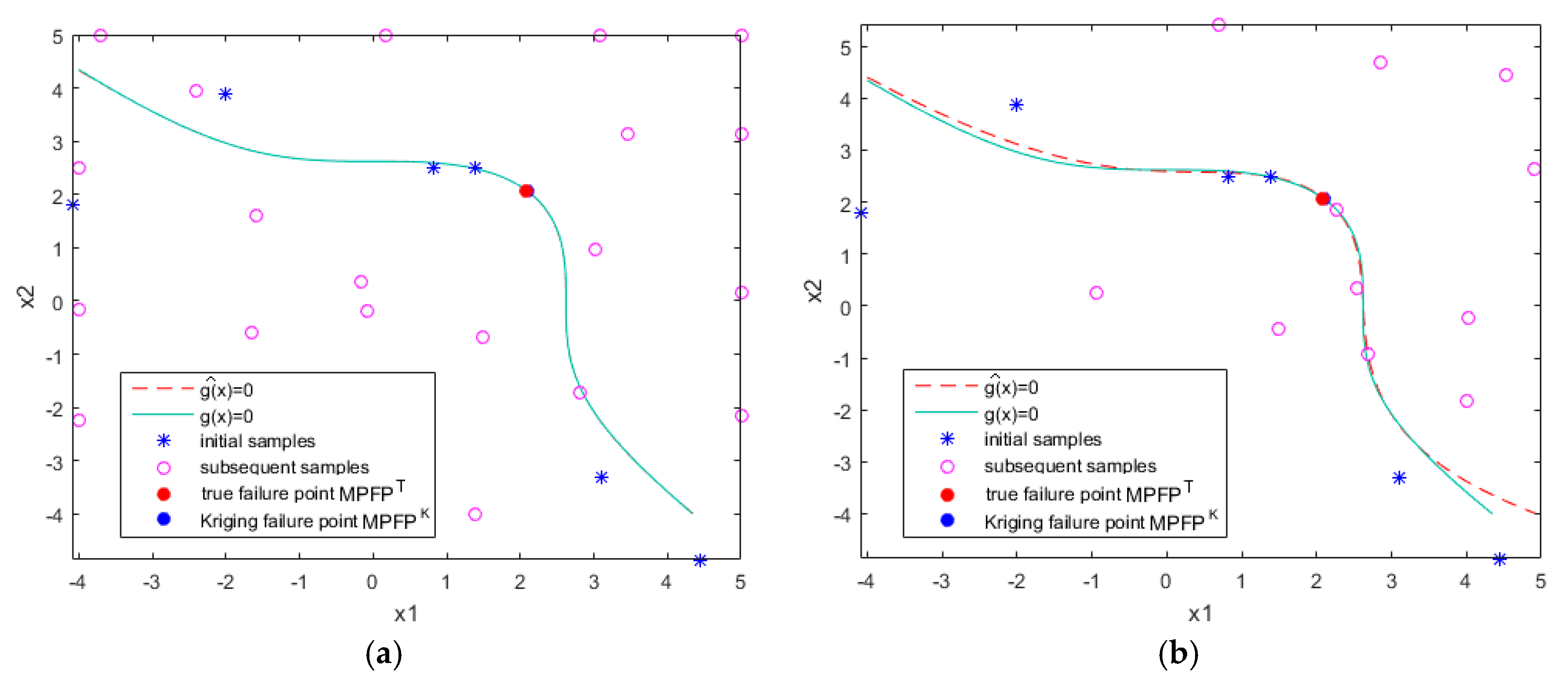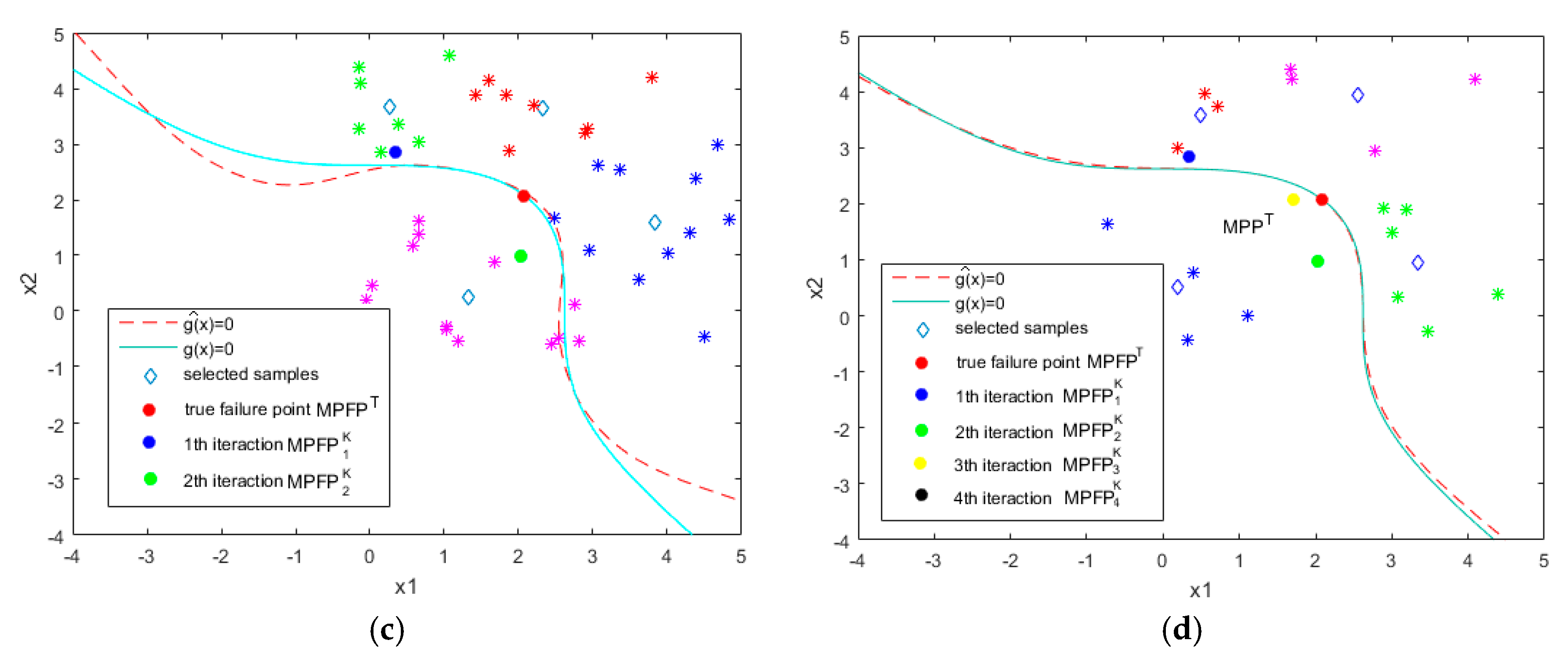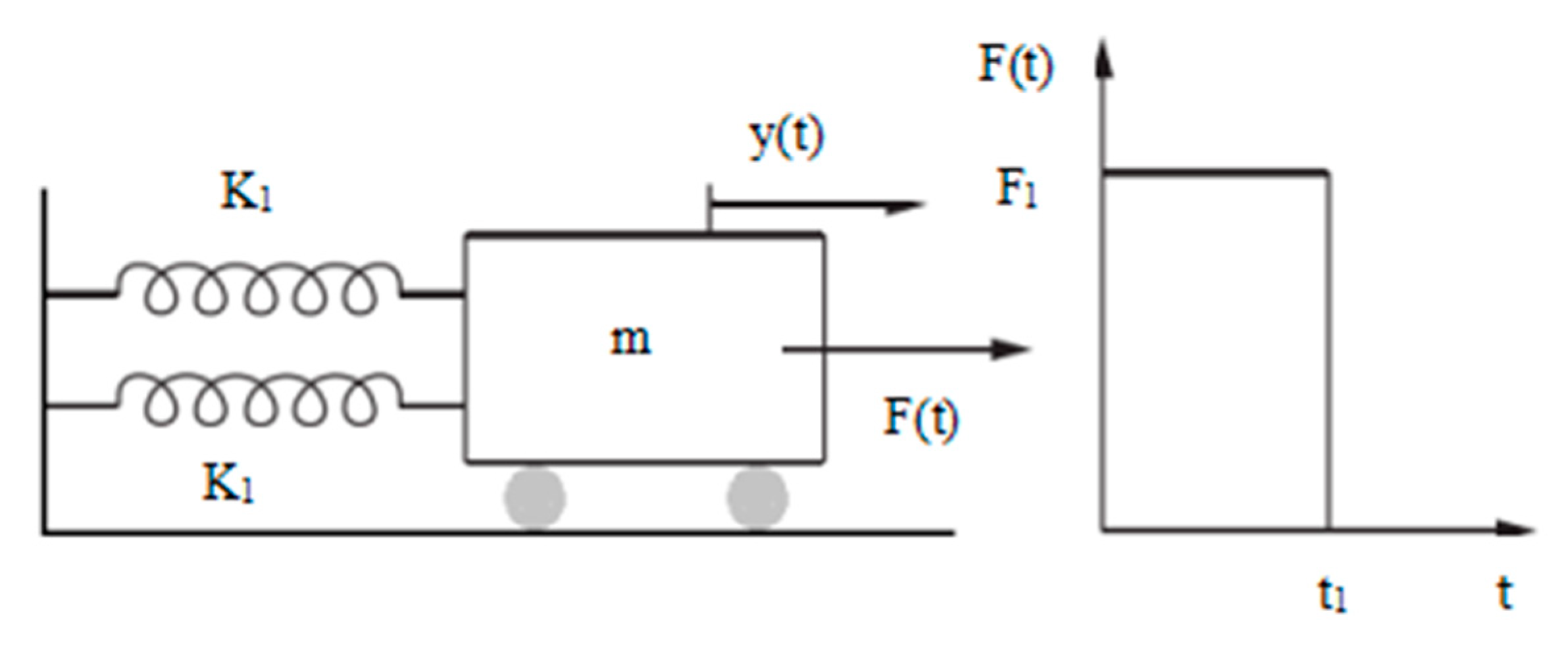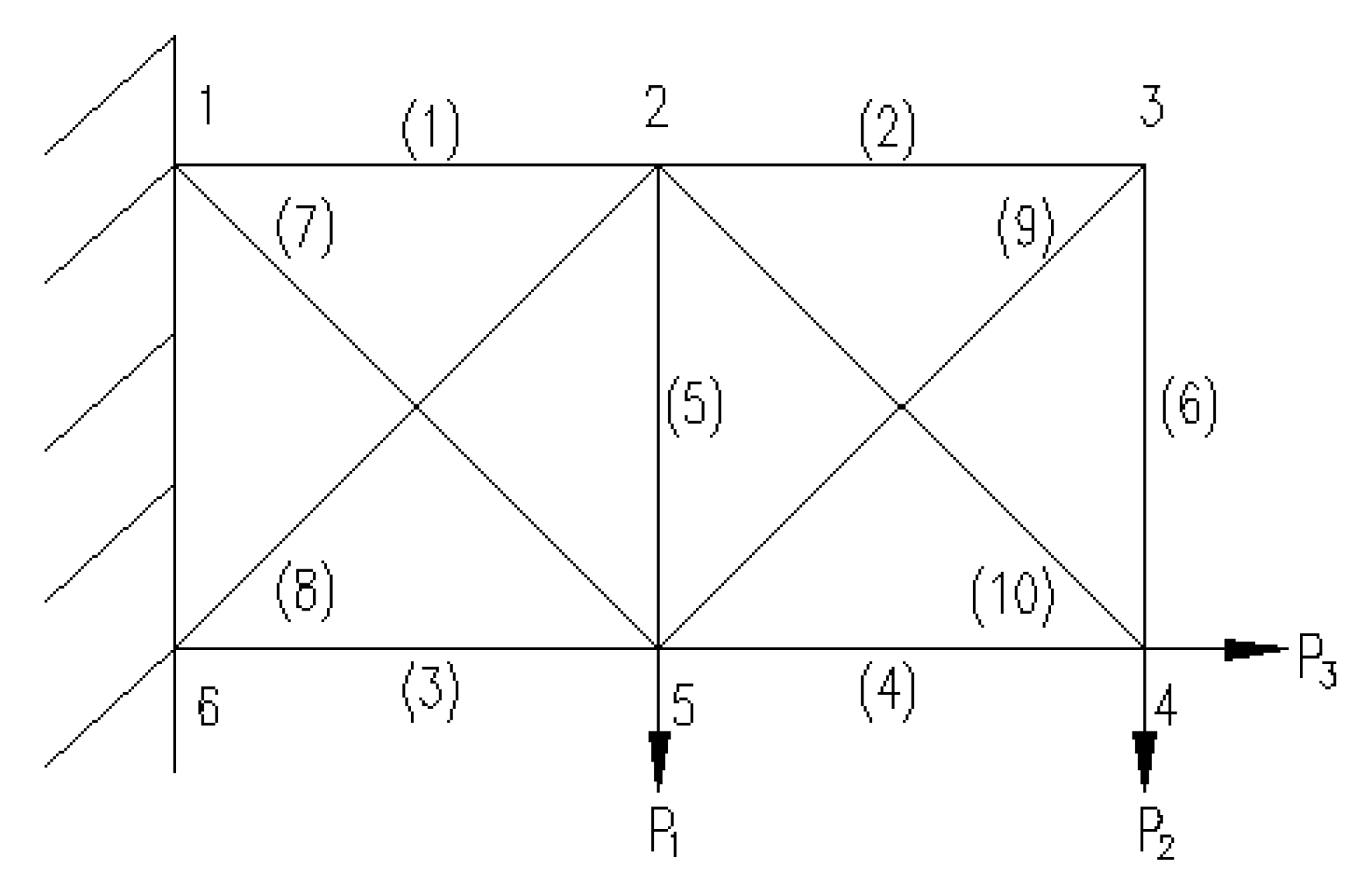1. Introduction
There are numerous uncertainties [
1] in the material properties, applied loads and geometrical characteristics of structures. The reliability analysis aims at considering the effects of these uncertainties and evaluating the failure probability of the structures. In order to carry out reliability analysis, various techniques have been presented in related literature. The Monte Carlo method (MCS) [
2] is a well-known algorithm and is considered as the reference approach. However, for the time-consuming models, low failure probabilities or large-scale models, the MCS method needs a very large number of evaluations of limit state function. Due to the large computational cost, the MCS is infeasible. Some approximation methods [
2] have also been developed, such as the First Order Reliability Method and the Second Reliability Method, which can deal with the failure surface of linear or second-order Taylor series approximation. Because they are based on the assumption that the limit state function is linear or quadratic, these methods may cause large errors when applied to engineer applications with a nonlinear limit state function.
In order to overcome these shortcomings, more advanced simulation methods have been developed. Examples of these methods are variance reduction strategies (subset simulation [
3,
4,
5,
6], line sampling [
7] and importance sampling [
8,
9,
10]). However, even if such techniques require much less numerical effort, computational costs are still prohibitively high. Several types of surrogate models have thus been proposed to replace the limit state functions in the reliability field, including quadratic response surfaces [
11,
12,
13], neural networks [
14], support vector machines [
4,
15] and Kriging [
16,
17,
18,
19,
20].
Unlike other surrogate models, Kriging not only provides the predicted mean value of the structural response, but also a measure of local errors. Based on the feature of the Kriging model, the sequential Kriging reliability analysis (SKRA) method has been proposed. Such methods include the efficient global reliability analysis (EGRA) presented by Bichon et al. [
21], the active learning reliability method combining Kriging and MCS (AK–MCS) developed by Echard et al. [
22], the metamodel-based importance sampling for structural reliability analysis proposed by Dubourg et al. [
10] and the Polynomial-Chaos–Kriging (PC–Kriging) proposed by Schöbi et al. [
23]. Whether the limit state function is non-linear or multimodal, they can significantly improve the accuracy of the reliability evaluation and reduce the number of calls to the actual performance function.
More recently, some improved approaches have been developed to improve the existing sequential Kriging reliability analysis methods. Wen et al. [
24] proposed an improved sequential Kriging reliability analysis method based on the EGRA. Sun et al. [
25] proposed an adaptive reliability analysis method that used the least improvement function. Gaspar et al. [
26] developed an adaptive surrogate model technique combining the Kriging and trust region method. Lelièvre et al. [
27] presented an improved AK–MCS method named AK–MCSi. Xufang et al. [
28] proposed a novel active learning function which is named expected improvement function (REIF).
In this paper, an improved EGRA algorithm is proposed to improve its accuracy and efficiency. It is well known that EGRA is a sequential reliability analysis algorithm. EGRA searches for sample points near the limit state function over the whole design space, and the point at which the expected improvement function (EFF) gets the maximum value is added into the DoE iteratively. In other regions, the high prediction accuracy is not required, because they are not critical. The results in the literature [
21] show that EGRA has high precision and efficiency. However, the EGRA algorithm still has the following drawbacks. The first is that EGRA fits the limit state function accurately in the whole design region. In reliability analysis, only the local region near the most probable failure point (MPFP) is required to be more accurate. Therefore, it is not necessary to select samples in the region that has little influence on the failure probability. The second is that EGRA is a serial reliability analysis algorithm. This means that the new candidate sample point cannot be determined until the simulation of the current sampling point is completed in each iteration. That is, it only adds one sample point to update itself at a time. Therefore, EGRA cannot handle simultaneous multiple calculations.
To overcome the drawbacks presented previously in EGRA, a new local approximation strategy based on the most probable failure point (MPFP) is proposed to improve the performance of the sequential Kriging reliability analysis. Unlike EGRA, which selects samples in the whole design space, the proposed method carries out sequential sampling in a local region near the current MPFP and new candidate sample points are selected in this local region. Moreover, the center and size of the next local sampling regions are not fixed, which are determined by the MPFP calculated by the last iteration. By focusing the samples near the MPFP, only a few real function evaluations are needed, and a high-quality Kriging model can be obtained with a small number of true function evaluations. Since the proposed method samples in the local region, which has a great influence on the result of reliability analysis and the size of the sampling region is changing, it is more effective than EGRA.
Besides, a multipoint enrichment technique is also introduced for parallelizing sequential Kriging reliability method. This technique uses a clustering technique to provide multiple points per iteration. Although this method may require more samples, due to the use of parallel technologies, it is much more efficient and less iteration than EGRA.
The remainder of this paper is structured as follows.
Section 2 briefly presents the theory of the Kriging surrogate model and the EGRA.
Section 3 proposes a local approximation method and introduces a multipoint enrichment strategy.
Section 4 presents the academic validation. Finally,
Section 5 provides concluding remarks.
3. The Proposed Local Approximation Method and Multipoint Enrichment Technique
In reliability analysis, the limit state constraint boundaries condition and local region near the most probable failure point (MPFP) are more critical than other regions. However, EGRA adds samples in the vicinity of the limit state function in the whole design space, which contains unnecessary regions. Therefore, it is more reasonable to add new samples in a small region around the MPFP on the limit state boundary.
3.1. The Local Approximation Region
3.1.1. Determine the Center of Locally Adaptive Sampling Region
It is well known that MPFP is very important in reliability analysis. It is located on the boundaries of limit state constraints and has the shortest distance to the current design point. In random variables space, MPFP is also the location point that has the greatest influence on the accuracy of failure probability calculation on the limit state surface. If MPFP is used as the center of the local sampling region, the newly added sampling points will be more distributed near the limit state surface and the MPFP. Moreover, if the sampling points are only selected in the local sampling regions, the number of iterations needed for EGRA can significantly reduce. Therefore, the MPFP obtained from the previous iteration by FORM algorithm is used as the center of the local sampling region of the next iteration in the proposed method.
3.1.2. Define the Size of Locally Adaptive Sampling Region
For reliability analysis problems, Bucher and Bourgund [
11] proposed a response surface method based on the Bucher-star design and quadratic polynomials. The Bucher-star design is a star-shaped design scheme as shown in
Figure 1. The points around the sampling center point are selected by deviating from a certain distance in the positive and negative directions of the coordinate axis of random variables. The deviation distance is generally
times the standard deviation of the basic random variables.
where
is the deviation distance of random variables
,
is the standard deviation of
and
is a factor which is used to define the size of sampling region.
It is well known that
is a very important index in reliability analysis, which represents the radius of hyper-sphere. Therefore, the local sampling region should not less than
. According to Zhao et al. [
29], the radius of hyper-sphere should be 1.2–1.5 times
based on the nonlinearity of the limit state function.
Inspired by the Bucher-star design scheme, a new method for determining deviation distance is proposed in this paper. The
is formulated as follows:
where
is the deviation distance of
,
,
denote reliability index and the scaling factor, separately. Then, in the proposed method, the size of the locally adaptive sampling region is defined as
instead of the fixed truncated simulation region
as in the EGRA method.
3.2. Multipoint Enrichment Technique
EGRA is a sequential sampling algorithm. In each iteration, only one point is added to update itself, so parallel computing is not possible. However, compared to running a single simulation, it is meaningful to perform multiple simulations at once. Although parallelization requires more samples to achieve specific accuracy, the time can be saved by simulating the response of the samples at the same time.
To select multiple sample points in each iteration, the
k-means clustering [
30] technique is provided in this paper. The
k-means clustering strategy is a partitioning method. It classifies a given data set into
k clusters by minimizing the sum of the distances between the centroid and all member objects of the cluster. The objective function is defined by Equation (10):
where
is the distance between a point
and the cluster center
.
The algorithm is summarized as following:
Randomly initialize the k centroids ;
Divide each sample into the cluster that has the closest centroid;
Calculate the centroid for each cluster again;
Repeat steps 2 and 3 until the centroids no longer change.
Figure 2 is an illustration of a two-dimensional example using the
k-means clustering technique. With this algorithm, sample points are divided into three clusters.
Since the limit state constraint boundaries condition and local region near the most probable failure point (MPFP) are more critical than other regions for reliability analysis, in this paper, the points with the expected feasibility larger than a threshold value in the local sampling region can be considered as members of the points set to be clustered. Then, those points are divided into k groups, and for each group, the points which have the largest expected feasibility value are selected as the candidate sample points for the Kriging model. Therefore, k sample points can be selected simultaneously.
5. Conclusions
In this paper, a local approximation method and a multipoint enrichment technique are proposed. The aim is to improve the accuracy and efficiency of EGRA. Compared with the existing EGRA method, the proposed method selects samples in a local region rather than in the whole design space. EGRA contains unnecessary sampling regions, which have little influence on the result of reliability calculation. It is well known that the accuracy of limit state function in the vicinity of MPFP is more critical than other regions in reliability analysis. Only the limit state function in such a region is accurately approximated can the analysis efficiency be improved significantly. Therefore, in the proposed method, MPFP is used as a sampling center in the local sampling regions, and the size of the local sampling regions is adapted according to the maximum of the standard deviation of the basic random variables and reliability index calculated by the last iteration. By confining the sampling regions to the local regions, the number of iterations is significantly reduced. In addition, to select multiple samples for enrichment in each iteration, a clustering technique is also introduced. By this way, only a few iterations are needed to get the desired results.
The proposed approach is evaluated by four examples. The numerical results show that the proposed method is able to deal with highly nonlinear limit state functions and has high accuracy and efficiency, even though the total number of calls to performance function is usually greater than EGRA. Since calls to performance function could be parallelized, the number of iterations seems to be a more appropriate measure. Thus, the proposed method is a promising approach for reliability computation.
However, it should be noted that the proposed algorithm, as other methods in the literature, is greatly influenced by the initial samples and relevant parameters. In future work, we will explore a more effective local initial sampling method and reasonably define the parameters of the method according to some prior knowledge.

